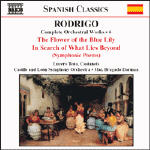Joaquín Rodrigo was born on 22nd November 1901 in Sagunto, in the Spanish province of Valencia. A bout of diptheria left him blind from the age of four, but it was ultimately as a result of this misfortune that he decided to dedicate himself to music. In 1906 the family moved to the city of Valencia, where Joaquín attended the local school for the blind. There he received his first music lessons and, on hearing Verdi’s Rigoletto, became convinced that his vocation was to be a composer. Between 1917 and 1922 he studied composition with Francisco Antich at the Valencia Conservatory. His earliest compositions date from 1922 and an orchestral work, Juglares, was first performed two years later. By then Rodrigo had come into contact with the new wave of avant-garde composers active in Madrid at the time but, on failing to win the National Music Prize in 1925, he decided to move to Paris where he studied under Dukas. He married the Turkish pianist Victoria Kamhi in 1933 – they were separated briefly before being reunited in Paris in 1935, Rodrigo having expressed his yearning for his wife in his Cántico de la esposa. The Concierto de Aranjuez, the work that established his reputation as a composer, was first given by the guitarist Regino Sainz de la Maza after the end of the Spanish Civil War. There followed the Concierto heroico for piano (1943), the Concierto de estío for violin (1944), Ausencias de Dulcinea for bass, four sopranos and orchestra (1948) and the Concerto in modo galante for cello (1949): the central works of his catalogue.
Orchestral Works
